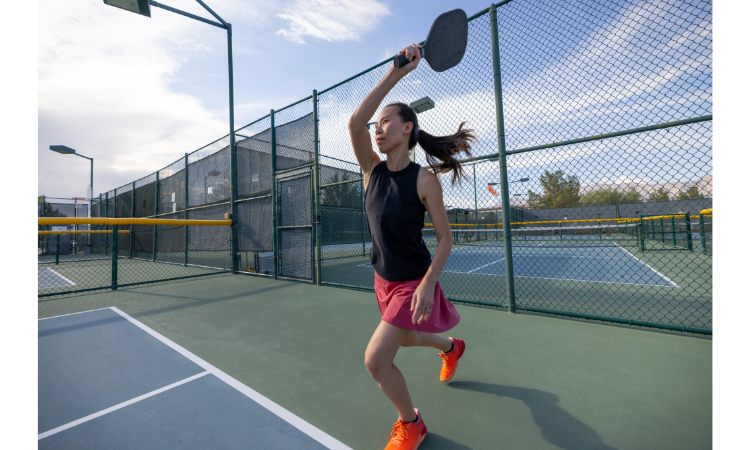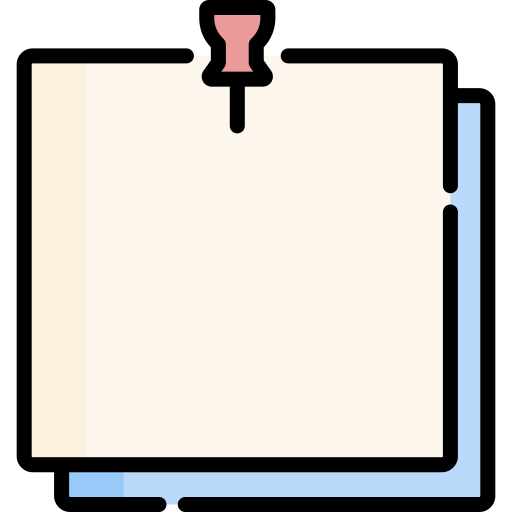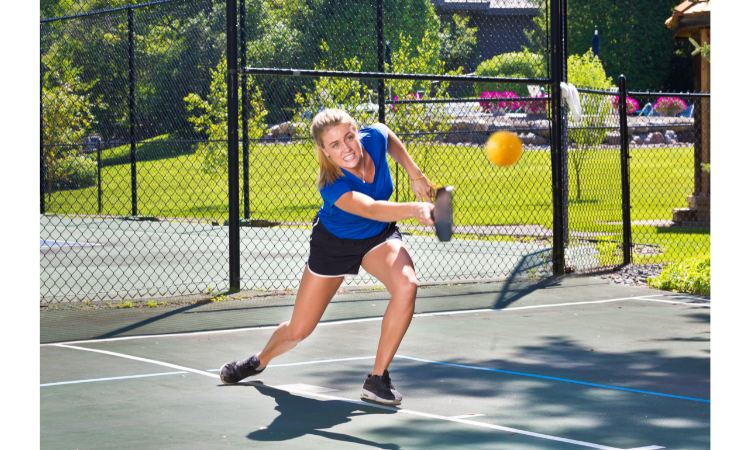Want to learn the pickleball singles rules? You’ve come to the right place. Luckily, the pickleball rules for singles are quite easy to grasp. Once you learn how to play the game, it not only becomes a great workout but an addicting hobby.
Pickleball single is a fantastic workout that involves using your fast-twitch muscles to get to the ball, which doesn’t travel that far off the bounce. This means you have to quickly move your body almost to where the ball landed if you want to hit it at the optimal time.
You only need one other player to practice singles with, which is great for casual players. Coordinating the schedules of four different people is a challenge in itself.
What Are the Pickleball Singles Rules?
Pickleball rules for singles are similar to the pickleball doubles rules, with slight variations. Understanding the pickleball rules for singles makes planning your strategy much easier.
Why is strategy so important in pickleball singles? Strategy is important here because the points are much shorter than you’d typically see in doubles, thus each stroke is critical. But before you think about what strategy is best for singles, let’s first master the rules for singles pickleball.
How to Start a Pickleball Singles Game
If you’re playing in a sanctioned tournament with a referee on the court, the first thing they may do is assess your paddle to ensure it meets all the requirements for tournament play. The rules for pickleball singles state that you’ll need to change to an approved paddle if your current one fails to meet the standards.
These regulations keep the game fair for all, as unregulated paddles may give an opponent an unfair advantage. For example, if the pickleball paddle is delaminated, the ball may come off the paddle much faster.
What Are the Paddle Rules for Pickleball Singles?
Major brands like Onix, Paddletek, Engage, CRBN, and Selkirk carry tournament-approved pickleball paddles.
According to the USA Pickleball Official Rulebook, there are several factors when determining if a pickleball paddle is up to code. Here are some of the basics:
- The paddle material must be rigid and non-compressible.
- The pickleball paddle surface should be free of delamination, holes, cracks, and indents.
- The paddle material must not be reflective since it can hamper your opponent’s vision.
- The combined length and width of the paddle should be at most 24 inches, with the length of the paddle itself only reaching 17 inches maximum.
- There are no restrictions on how thick the paddle can be.
- You can make alterations to your paddle on the edge guard, grip, and name decals on the paddle face.
- The pickleball paddle must have the brand or model information marked on the paddle..
How to Determine Sides, Server, and Returner
After the referee deems each player’s paddle meets the regulations, they will flip a coin. The winner of the toss gets to choose whether to pick a side to play on or choose to serve/return. If player A chooses a side, player B can choose whether to serve or return first and vice versa.
How to Win in Pickleball Singles
There are three types of scoring systems you may experience when playing singles.
-
Two out of Three Games
The player has to win two out of three games by scoring 11 points per game and winning by two points. In this scenario, each person plays an entire game on one side of the court. After a winner is called, players will get a two-minute break before switching sides to start the next game.
What happens if player A and player B both get 10 points each? The game is extended until a player finally wins by two points. If player A gets two more points for a total of 12, and player B is stuck with 10, then player A wins the round.
If each player wins a game, they will play a third game to determine a winner. In the third game, the players switch sides when one player gets to 6 points.
2. First to Reach 21 Points Wins
In the second scenario, the first person to get to 21 wins. Again, a player must win by two points for the game to end. This is an abbreviated traditional scoring format, except the third game is removed.
Players still receive a two-minute break during the side change when a player gets to 11 points. Some tournaments may use this format if there is a weather delay and they need to get through the matches faster.
3. First to Reach 15 Points
The third format is a game to 15, where players change sides at 8 points. Players still need to score two points more than their opponent to win the round.
Many will see this format in the back draw, aka the consolation bracket. The back draw is an opportunity bracket that players funnel into once they lose a match in the main draw.
The Scoring Rules for Pickleball Singles
In order to score a point in singles, a player must win a rally during their serve. This makes the game more challenging because not only does a player have to serve the ball and win a rally to score a point, but each player also has to follow the two-bounce rule in singles.
The two-bounce rule states that each player must let the ball bounce on both sides of the court before either of them can hit a volley. This rule was established to even the playing field for both players.
How? Because the returner cannot score a point if they win a rally. However, because the returner can volley before the server, they have a better chance to be in an offensive position to win a point.
Player Position Rules for Pickleball Singles
The score dictates where each player positions themselves for the serve and return. When the score is even for the server (0,2,4,…), the player must serve the ball on the right side of the court. If the server’s score is odd (1,3,5,…), the serve is made from the left side.
What if the returner’s score is odd and the server’s score is even? Does the returner stand on the left side because their score is odd? No, the returner has to stand diagonally across from the server. If the server is on the left side of his court, the returner should also be on the left side of his court.
It is important for players to keep track of their scores at all times. If the score is called and a player is standing in the wrong position, that player loses the rally.
Pickleball Singles Rules for Serves and Returns
Serves and returns are crucial in singles because the rallies are considerably shorter than doubles. An average rally in doubles is six shots or more, while an average singles rally is four shots.
In order to put yourself in a winning position early, the serve and return should be aggressive enough to dictate the point. But in order to dictate play with your serve or return, you need to know the basic pickleball singles rules for serves and returns.
Serve Rules for Pickleball Singles
There are two types of serves: a volley serve and a drop serve.
- A volley serve is when you hit the ball out of the air with either a forehand or backhand motion. Check out the volley serve rules below.
- Your arm must go in an upward direction upon contact with the ball.
- The highest part of the paddle head must be below the wrist on contact.
- Your contact point should be below the waist.
- Both feet must be behind the baseline before and during contact. After contact, one foot must be established behind the baseline before moving to the next shot.
2. A pickleball drop serve is when you drop the ball and hit a groundstroke off of the bounce. These are the rules for hitting a legal pickleball drop serve.
- You can either drop the ball from one hand or from the paddle face.
- You cannot throw the ball down or toss the ball up to create more speed on the drop serve.
- Both feet must be behind the baseline before and during contact. After contact, one foot must be behind the baseline before making the next shot.
You must hit your serve crosscourt and pass the kitchen line. If the serve lands in the kitchen or on the kitchen line, or if any of the volley or drop serve rules are violated, this results in a fault, and the serving side loses the rally.
Pickleball Singles Rules for Returns
The rules for returning are simple. Thanks to the two-bounce rule, you can only hit the return after the ball bounces once on your side. It must land anywhere in bounds on the opposite side of the court. If the ball lands anywhere on the line, it is considered “in”.
Kitchen Line Rules for Pickleball Singles
Section 9.A.-C. states that you can only volley the ball if your feet are established behind the kitchen line. Your feet should also be behind the line during the swing and follow through. If your momentum causes your body or paddle to touch anywhere inside the kitchen, it’s considered a pickleball kitchen violation.
You can only step into the kitchen after the ball bounces. This is called a dink and is used frequently when playing pickleball.
A player may return the ball, even if their opponent is still in the kitchen. However, if you are in the kitchen or on the kitchen line, and push off to hit the ball out of the air, this results in a fault.
Is an Around-The-Post Shot Legal in Singles?
Yes, and it is a shot that many players are mastering in singles. An around-the-post shot (ATP) is where a player waits for the ball to travel beyond the sideline and hits the ball around the post, literally. The ball does not need to clear the net, making this shot a fun one to hit. If you hit this shot on camera, make sure to put it in your highlight reel?.
Time-Out Pickleball Singles Rules
Each team has two time-outs per game when playing a game to 11 or 15. If games are played to 21, players can receive three time-outs. The players must inform the referee or opponents that they are taking a time-out. The time-outs are one minute long. If a player does not resume play after the time allotted, they may get a warning from the referee or result in a fault.
What Are the Rules for Skinny Singles Pickleball?
The rules for skinny singles pickleball are identical to the rules for singles pickleball, except you only play on half of the court. For example, if the server score is even, both players start on the right side of the court and must hit the ball ONLY on the right side of the court. If the ball lands on the left side of the court, it’s considered out.
Since the rules for skinny singles pickleball state that you can only hit crosscourt, are around-the-post (ATP) shots legal? Yes, they are legal. This is the only exception to the cross-court rule.
During skinny singles, a person can hit an ATP shot down the line or crosscourt. This teaches the players to be aware of hitting a sharp crosscourt dink. In doubles or singles, hitting a sharp crosscourt dink can be dangerous because it’s easier for their opponent to hit an ATP shot, which is hard to defend and puts your team in a bad position.
Final Thoughts
Play singles! It’s physically and mentally challenging and great for practicing your shots for doubles. If you’re looking to break into the pickleball scene and rise in ranks, the singles draw is a wide-open field. Many players focus on doubles because it’s easier on the body. But if you’re physically fit enough to do singles, go out there and enjoy it!





































